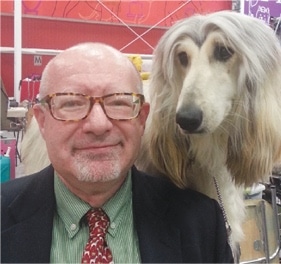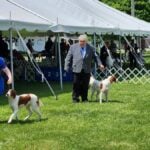
Home » Sendero Briards | Merry Jeanne Millner
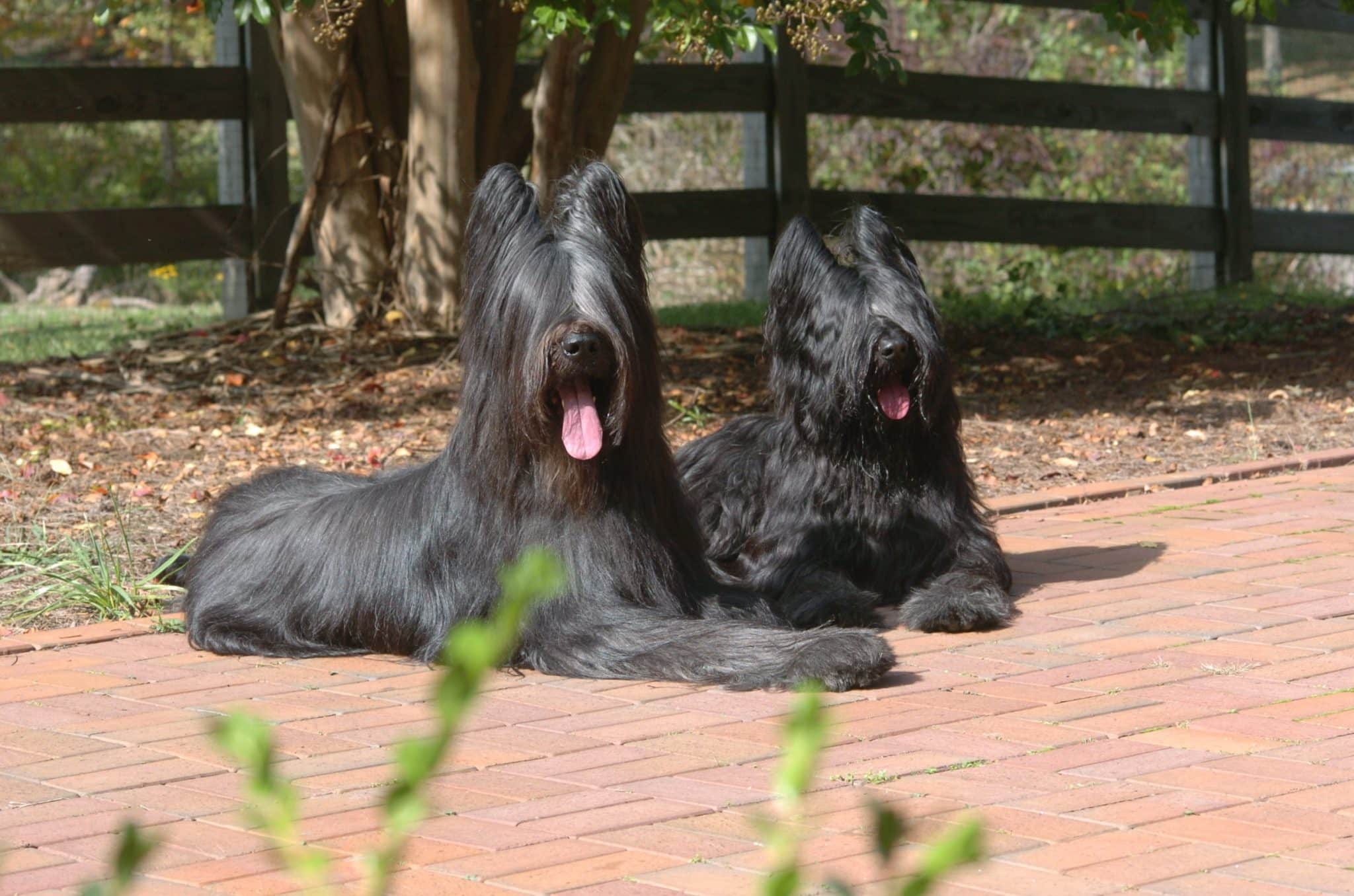
Sendero Briards | Merry Jeanne Millner , talking about her interests, introduction with Briard dog breed, dog show experience, and more.
Where did you grow up?
I was born in Monticello, Georgia, and then my family moved to Atlanta when I was a young child. I graduated from high school in Atlanta and then attended the University of Mississippi. Tommy was born and raised in Newport News, Virginia, and he graduated from Randolph Macon College. We are hardcore Southerners through and through!
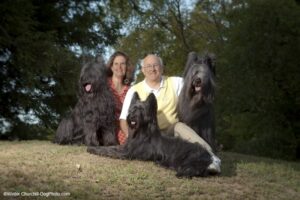
Do you come from a doggy family? If not, how did the interest in breeding and showing purebred dogs begin?
We always had dogs as a family. I grew up with a wonderful Chow and a Toy Poodle. We showed American Saddle Horses. My mother drove fine harness, and my sister and I rode walk-trot horses. As a family, we were all very involved in the world of showing horses. Tommy also grew up in a dog family with a blend of mutts, a Poodle, and a Beagle he took to college. When Tommy and I purchased our first Briard, I took the dog to an obedience class and our instructor happened to be very involved in showing, both in obedience and conformation. Shirley Probert was a huge, positive influence in our early days.
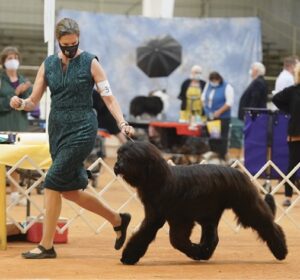
Who were your mentors in the sport? Please elaborate on their influence.
Kathy Fitzpatrick and Meg Weitz helped us so much in the beginning. Kathy was my first contact in starting my journey into the world of Briards and the Briard Club of America. She was very kind and patient, and did not laugh out loud at some of my most ridiculous questions. I am very proud to say that Kathy has several of our Briards and has put championships on them, including Master Agility Champions! We purchased our first show dog from Meg and she was a strong influence on my breeding program. She helped us tremendously in making those first breeding decisions. A bitch we got from her, Gillian, gave us our first homebred champions as well as our first Best in Show bitches. These girls were the first gray or black Briards to win Bests in Show.
The Sendero Briards are widely known, highly successful and well respected. What breeding philosophies do you adhere to?
I don’t really have a strict philosophy that I stick to. You study your pedigrees and then you have to look at the individual dogs and make sure that the pedigrees and the dogs are a great match. We have imported several dogs over the years that have made a huge impact on our breeding program, so learning both the American and the European pedigrees has been crucial to our program. I also have to say that sometimes you have to go with your gut. One of my successful litters was not exactly “pretty” on paper. But I have some beautiful and successful dogs, and they have made a huge impact on my breeding program.
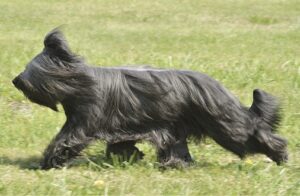
A key factor we never forget is to be true to the purpose of our breed. In the case of Briards, they must be able to move in “quicksilver” fashion, to quote our standard, as their job was to be a living fence for a flock. They were also guardians of the flock, so maintaining a bit of aloofness and a wary eye are important aspects of breeding proper temperaments.
How many dogs do you currently house? Tell us about your facilities and how the dogs are maintained.
We have moved back to my starting place and are now living in Monticello, Georgia. Our home was built in 1850 and was at the epicenter of Sherman’s path in his march to the sea. Fortunately, our home was saved from destruction and represents the ideal of Italianate architecture in southern antebellum homes. For us, this means plenty of room for lots of house dogs. At present, we have eight dogs in the house, all over the age of 9, so it feels like a retirement home at times. Luckily, they are all vibrant and healthy, so we are very blessed! Sadly, our oldest boy, Thunder, died several weeks ago at the grand old age of 14. Over the years, we have always had a separate kennel where we keep from six to eight young dogs. That is the case here in Georgia where we converted a beautiful horse barn into a state-of-the-art kennel. We are so lucky to have had in the past—and to have now—some wonderful people to help us care for the dogs. Lauren and Emily Oliva run the kennel and help with everything from grooming to training and, of course, lots of puppy playing!
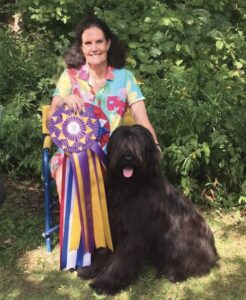
Who were/are some of your most significant Briards, both in the whelping box and in the show ring?
Our foundation bitch, Ch. Gillian de Bejaune, had a huge impact on our breeding program. “Gilli” produced the first two black/gray AKC Best in Show winners in history (Remington and Lilli) and really set us on our way. Remington (BIS CH Sendero’s Lil Lead Shot HIC TT ROM HOF) was probably the most influential in the whelping box. While she was very successful in the ring, her one and only litter was spectacular. Most of her get have made a very positive impact on our breeding program. We imported Abbado Arte Cassarri and he, so far, has probably been the most influential male in our breeding program. He is found in the pedigrees of the majority of young dogs we have today.
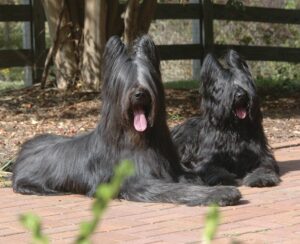
As far as our stars in the ring, I am very proud to say that we have had so many. I think if I had to pick my top four it would be the boys, BISS BIS GCHG Lightning Strike El Xargall (Thunder) and UK CH BISS BIS GCHG Sendero’s Here we Go at Charson (Neyo). It just took my breath away to watch these two handsome boys glide around the ring, and with such great outlines. Both won Briard Club of America National Specialties. My girls would have to be BISS BIS CH Sendero’s Sterling Gray Ghost (Derby) and BIS BISS GCHG Ne Orageux’s Flash Point (Sparkles). These girls, too, would glide around the ring, and their outlines were the epitome of what a Briard should be!
Please comment positively on your breed’s present condition and what trends might
bear watching.
I am pleased to say that I think the Briard is doing very well and is in good shape. The improvement in our temperaments is phenomenal. I think we are maintaining our beautiful outlines that say, “Briard.” I do worry that we need to watch our tails as we are losing a very important hallmark of the breed, our “J” tail. We will always be fighting the straight shoulders, which can produce a very stilted movement. I think my biggest concern is that our breed is now being trimmed and dyed. While this does not come from mistakes in the whelping box, it is certainly a big mistake for any owner or breeder to either dye and trim, or allow a handler to dye and trim our
beautiful breed.
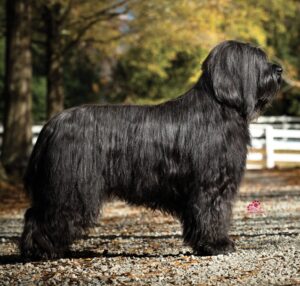
The sport has changed greatly since you first began participating. What are your thoughts on the state of the fancy and the declining number of breeders?
A real concern is the aging of the breeder base in our breed—and all others for that matter. Just look around and you will see very few young folks developing breeding programs like we did 35 years ago. Clearly, there are exceptions like Justin and Cheslie Smithey in Whippets, and several others, but most of us are in our late 50s and 60s, and we aren’t being replaced. This is so interesting when juxtaposed against the huge demand for dogs that we are witnessing today. In our view, this lack of purpose-bred dogs has opened the door for “doodle mania” to take hold as we have all witnessed. How do we encourage newcomers to join us and remain in the sport? It needs to be multi-faceted as no one silver bullet exists to solve the problem. Breeders need to develop mentorship programs to keep their programs thriving into the future… succession planning, if you will. Bring a young person in the fold, train them, and nurture their development. AKC needs to massively promote purpose-bred dogs and the health testing that goes into these breeding programs. We also need to laud the fun that you can have with a purpose-bred dog, from scent work to agility—and everything in between. We can win this battle!
Where do you see your breeding program in the next decade or two?
Our goal is clear… to keep breeding beautiful, healthy, well-tempered Briards that build on the hard work that we’ve invested in breeding to the Briard standard for the last 35 years.
Finally, tell us a little about Merry Jeanne outside of dogs… your profession, your hobbies.
Tommy is an avid golfer, so he stays very busy in retirement. I am afraid the dogs are my hobby and take up most of my time. I just enjoy being with close friends, sharing life!
